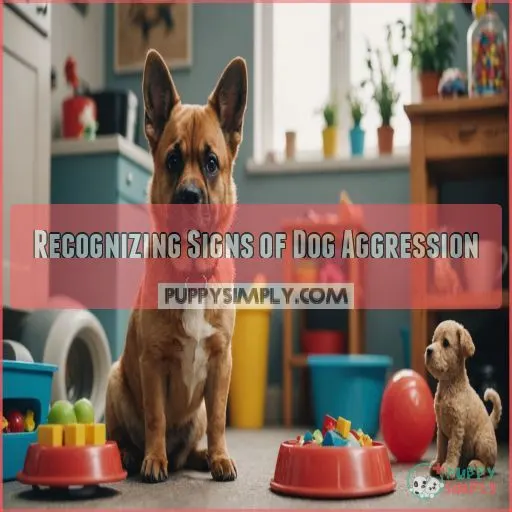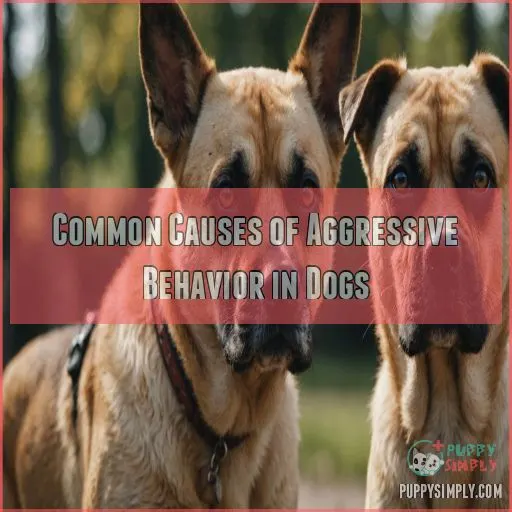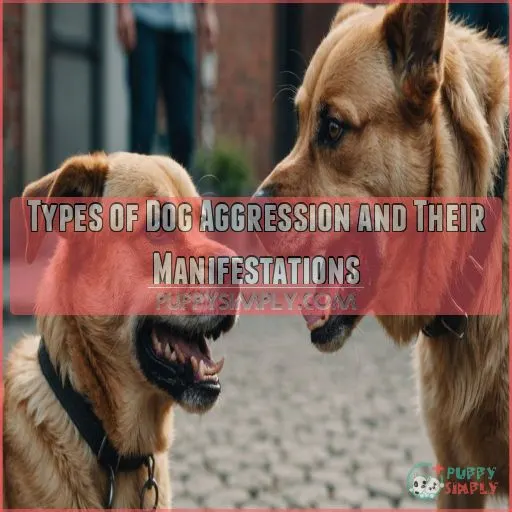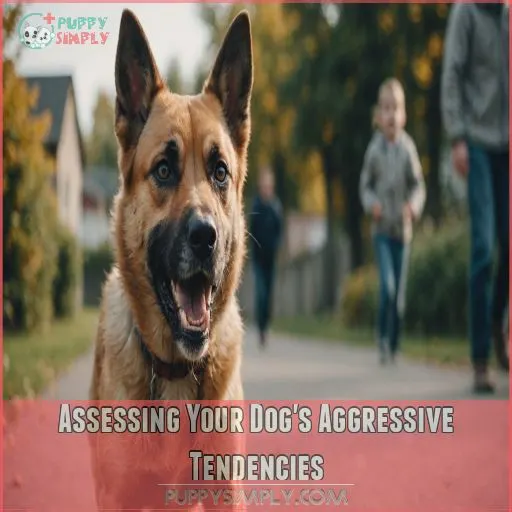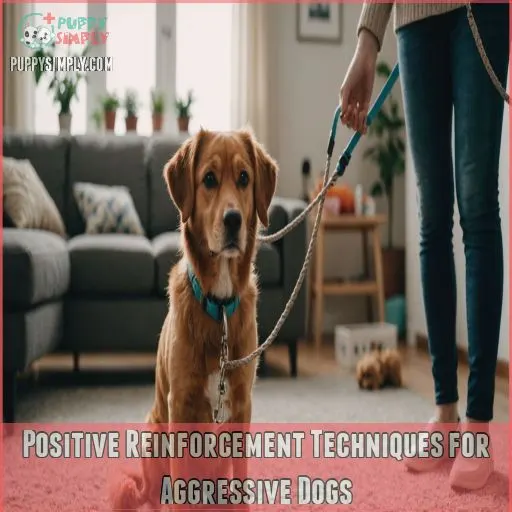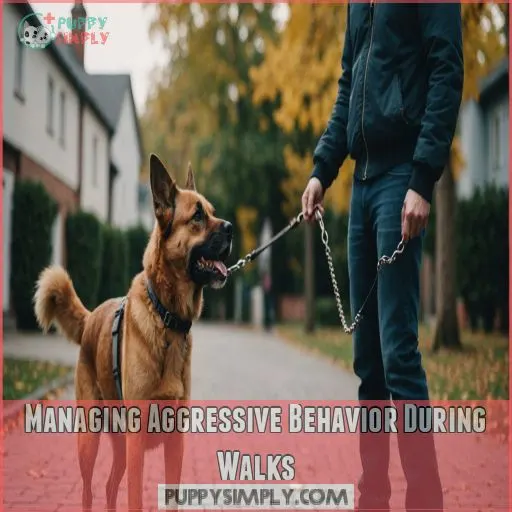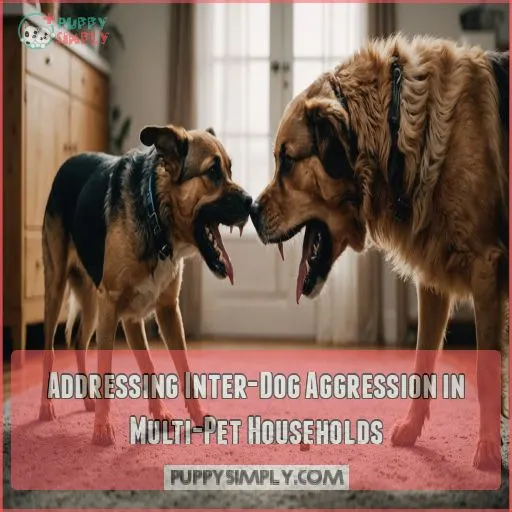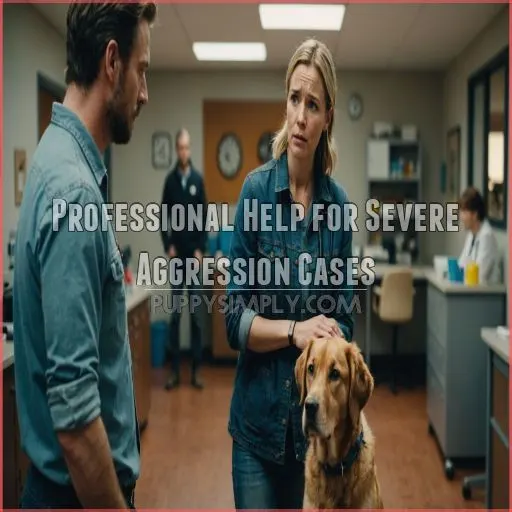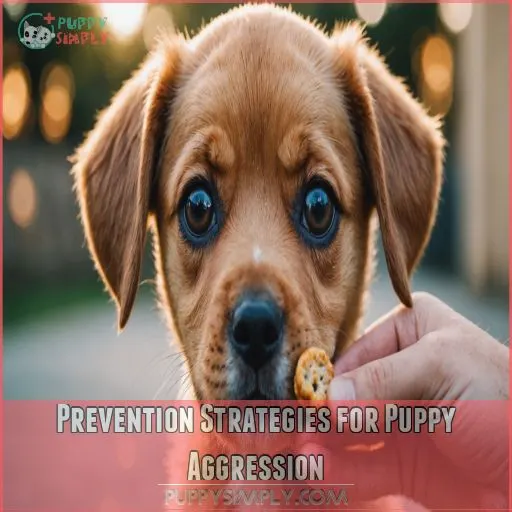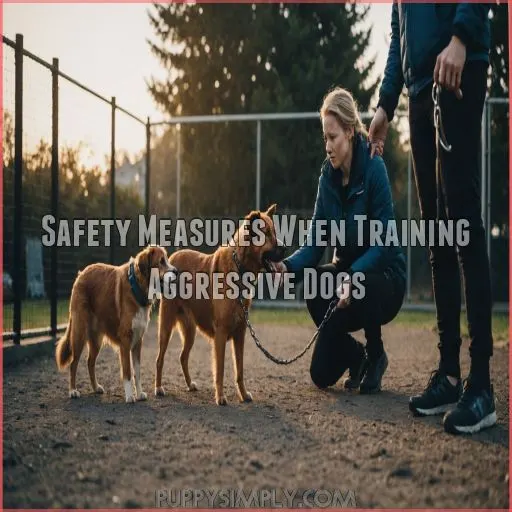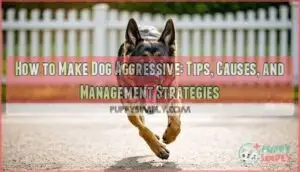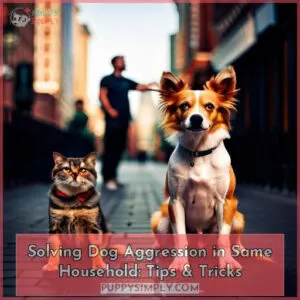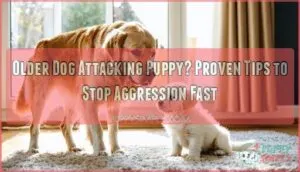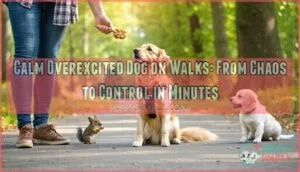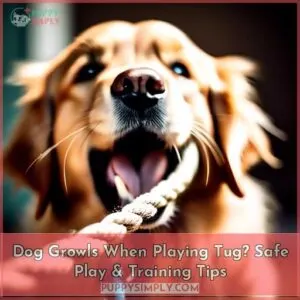This site is supported by our readers. We may earn a commission, at no cost to you, if you purchase through links.
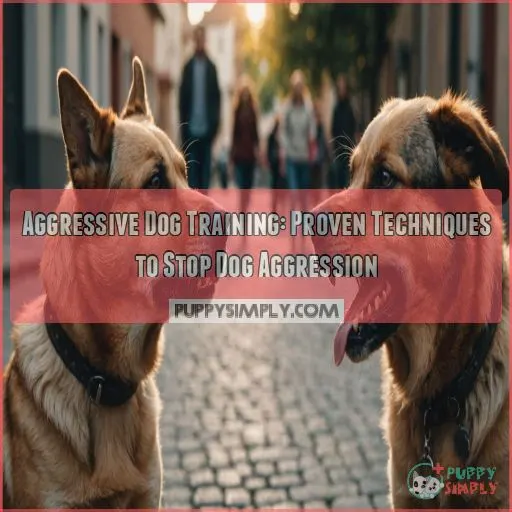
Embrace positive reinforcement training to channel that energy into good behavior—think treats, clickers, and a bit of praise. Always keep safety a priority. If things get ruff, consult a pro.
And remember, you can’t teach an old dog new tricks overnight, but every good behavior gets you one wag closer to harmony. Ready to dive deeper into dog training aggression issues?
Table Of Contents
- Key Takeaways
- Recognizing Signs of Dog Aggression
- Common Causes of Aggressive Behavior in Dogs
- Types of Dog Aggression and Their Manifestations
- Assessing Your Dog’s Aggressive Tendencies
- Positive Reinforcement Techniques for Aggressive Dogs
- Managing Aggressive Behavior During Walks
- Addressing Inter-Dog Aggression in Multi-Pet Households
- Professional Help for Severe Aggression Cases
- Prevention Strategies for Puppy Aggression
- Safety Measures When Training Aggressive Dogs
- Frequently Asked Questions (FAQs)
- Are You dealing with dog aggression?
- How can I handle aggression and agitation in a person with dementia?
- Do dogs have a higher risk of aggression?
- Do dogs have a fear based aggression problem?
- Is it possible to train aggression out of a dog?
- What calms aggression in dogs?
- How to discipline a dog for being aggressive?
- When to put down a dog for aggression?
- How can I address my dogs resource guarding?
- What triggers aggression post-dog attack experiences?
- Are lifestyle changes necessary for aggression management?
- How does leash reactivity relate to aggression?
- What role does a dogs daily routine play in aggression?
- Conclusion
Key Takeaways
- Understanding your dog’s body language is like reading a silent novel. Look for stiff postures, intense stares, and vocal cues—like growls—as signs that your pooch might need some space. It’s all about being the Sherlock Holmes of canine emotions!
- Positive reinforcement is your magic wand for transforming aggression into wagging tails. Treats, clickers, and a hearty "good boy" can turn a grumpy growler into a cheerful chum. Remember, Rome wasn’t built in a day, and neither is a well-behaved pup.
- Figuring out your dog’s triggers is like detective work. Does your pup guard kibble like it’s gold? Understanding what sets them off helps prevent those drama-queen moments and keeps the peace at home. Channel your inner detective and observe your furry friend’s "episodes."
- Sometimes, managing aggression feels like walking a tightrope, but seeking professional help can be your safety net. If aggression feels overwhelming, a qualified behaviorist might just be the superhero you need—cape not included!
Recognizing Signs of Dog Aggression
Understanding your dog’s aggression starts with recognizing the signs, and it’s a bit like reading their personal drama signals.
From body language cues like stiffened posture to vocal warnings such as growls, identifying triggers and escalation patterns is key to keeping the peace and avoiding doggie theatrics.
Body Language Indicators
Recognizing your dog’s body language can be like reading a book without words.
Canine aggression is often signaled by stiffening, intense stares, or raised hackles.
Tail-wagging doesn’t always mean happiness; sometimes, it’s a stiff signal.
Be alert to subtle cues like lip-licking or yawning, which might indicate stress.
Stay curious and observant!
Vocal Cues and Warnings
Dogs speak in a symphony of sounds—growling, whining, barking, yapping, and even sniffling—to tell you a tale.
A growl isn’t just noise; it’s a flashing sign in neon: "Step back!"
When dogs express their emotions vocally, they’re sharing their discomfort or fear.
Knowing these dog aggression signs can keep the peace and save face—or fingers!
Trigger Identification
Figuring out what sets off your furry friend’s inner grump takes a bit of detective work.
Look for trigger types—fear aggression or possessive snaps—when things get tense.
Does Fluffy guard treats like it’s gold? Or bark at visitors like they’re invading a castle?
Identifying these triggers helps in trigger management and prevention, keeping wagging tails in check .
Escalation Patterns
Now that you know the triggers, let’s chat about spotting those early warning signs before things go south.
A wagging tail can become a growl in the blink of an eye.
Keep your eyes peeled for body language shifts and trigger thresholds.
Mastering de-escalation strategies and calming techniques is key in dog aggression training to prevent that dreaded dog bite .
Common Causes of Aggressive Behavior in Dogs
Understanding why dogs become aggressive helps you address the root of their behavior instead of just treating the symptoms.
From guarding prized bones to feeling trapped or frustrated when left alone, knowing these causes can make all the difference in achieving a peaceful household.
Because even Rover has his moments, knowing why dogs become aggressive is crucial.
Fear And Pain [0
If your pup is acting aggressive due to fear or pain, it’s really important to identify the triggers.
Look for signs like cowering, trembling, or exaggerated yawning – these may indicate an underlying fear or discomfort.
By addressing the root cause, you can help your dog feel safe and secure, reducing aggressive outbursts.
Resource Guarding Behaviors [1
When Fido suddenly guards his kibble like it’s prime real estate, you’re witnessing resource guarding—a common canine behavior. Your pup might think that prized chew toy is worth more than gold! Understand triggers like perceived scarcity or past experiences.
Consider consulting a dog behavior consultant for guidance. Consistency and patience are key to easing food aggression and creating harmony at home .
Frustration-Elicited Aggression
Feeling like your dog guards toys like a gold miner clutching their last nugget? Meet frustration-elicited aggression!
It pops up when dogs can’t have what they crave, turning their leashes into chew toys.
Address this by:
- Ensuring enough exercise for zoomies
- Providing mental stimulation like puzzle feeders
- Spotting triggers to intercept boredom aggression before it hits .
Types of Dog Aggression and Their Manifestations
Understanding different types of dog aggression is key to managing your furry friend’s behavior, whether they’re guarding their favorite shoe or protecting their territory from an "intruder" squirrel.
Let’s break down these behaviors in a way that’s as simple as fetching a stick, so you can tackle them confidently and effectively.
Fear-Based Aggression
Fear-based aggression is your dog’s way of saying, "Yikes!" to perceived threats.
Watch for triggers like loud noises or unfamiliar faces, prompting anxiety-driven behaviors like growling or snapping .
Tackle this with confidence-building dog training and manage stress through positive reinforcement.
Remember, patience and kindness go a long way in turning "scary" into "manageable.
Resource Guarding
Dealing with resource guarding—those growls over toys or sudden stiffening when you get too close—might feel like negotiating with a grumpy, furry banker (Source). Your pup thinks they’re the CEO of toys and treats.
Calmly redirect using higher-value items to trade and reinforce sharing behaviors.
Early training steers clear of this tricky behavior, especially in shelters .
Territorial Aggression
Who doesn’t love their own space? Dogs certainly do! Territorial aggression kicks in when Fido thinks strangers have invaded his turf. Barking and lunging at visitors may arise because of misinterpreted "danger".
Master leash control and teach him that guests aren’t bandits.
Create safe zones. Correct boundaries can transform your multi-dog household into a peaceful haven .
- Teach "settle" commands
- Control window views
- Use treats for calm behavior
- Practice visitor introductions
- Manage space with gates
Redirected Aggression
Redirected aggression can strike when your pup’s pent-up frustration or excitement gets misdirected at an innocent bystander. Stay alert for signs like growling or snapping if you try to interrupt their focus. The key is managing their environment to prevent these outbursts and teaching alternative, positive behaviors through reward-based training.
Pain-Induced Aggression
Imagine a dog growls when you touch its sore paw—it’s likely experiencing pain-induced aggression.
This behavior change acts as a cry for help, signaling a need for vet diagnosis and treatment.
Alleviating discomfort can transform a grumpy growler into a tail-wagging companion.
Remember, sudden dog aggression, even when directed at children or pets, often masks hidden pain .
Assessing Your Dog’s Aggressive Tendencies
You’ve explored types of dog aggression, but how do you assess your own dog’s tendencies?
Start by observing your dog’s reactions to potential triggers like strangers or loud noises.
Does Fido bark like he’s the neighborhood watch, or is he just saying hello in his own way?
Identifying patterns is key.
When does your dog seem more aggressive—around other dogs or when guarding toys?
Breed predispositions might play a role, but every dog is unique.
Watch for body language: stiff posture, excessive barking, or growling are clear signs.
Your actions matter too.
If you stay calm and consistent, you’re sending good vibes his way.
A little patience and keen observation can work wonders in your dog aggression management journey (Source).
Positive Reinforcement Techniques for Aggressive Dogs
Are you ready to turn your dog’s aggression into a story of progress and wagging tails?
With positive reinforcement techniques, you’ll find that rewarding good behavior, building trust, and using clever strategies can transform your furry friend’s aggressive tendencies into cooperative and happy interactions.
Reward-Based Training Methods
Training aggressive dogs with reward-based methods is like guiding a ship through calm waters.
Focus on:
- Clicker training: Mark and reward good behavior.
- Treat rewards: Use tasty incentives your dog loves.
- Reinforcement schedule: Keep it consistent and frequent.
- Positive reinforcement: Celebrate small victories consistently.
Embrace these techniques to steer your furry friend toward calmer seas, fostering trust and cooperation.
Desensitization Strategies
Reward-based training methods help build trust, and now let’s explore desensitization strategies—your secret weapon against dog aggression.
Imagine gently introducing fearful triggers like vet visits or grooming.
Gradually expose your dog to noise sensitivity with calm reassurance and treats.
This approach turns fearful situations into manageable ones, placing you firmly in the driver’s seat of your dog’s emotional journey .
Counter-Conditioning Approaches
Tackling dog aggression? Try counter-conditioning methods to change your dog’s tune.
Think of it like replacing a scary movie soundtrack with cheerful music.
Pair feared triggers like other dogs with rewards.
Here’s a quick checklist:
- Identify triggers.
- Start with low-intensity stimuli.
- Gradually increase exposure.
- Reinforce with treats or toys .
Building Trust and Confidence
Building trust and confidence with an aggressive dog takes time and patience, but it’s so worth it.
Offer treats and praise when they display calm, non-aggressive behaviors, and create a safe, predictable environment where they feel secure.
With consistent, positive reinforcement, you can help your pup overcome their fears and learn to trust you.
Managing Aggressive Behavior During Walks
Managing your dog’s aggression during walks can feel like trying to keep calm in a rainstorm with no umbrella, but don’t worry—you’re not alone.
With the right mix of leash handling, distractions, and focus commands, you can transform tense strolls into peaceful jaunts around the block, giving you both a chance to enjoy the great outdoors again.
Proper Leash Handling Techniques
Mastering leash handling makes a world of difference when managing aggressive dogs during walks.
Start with a loose leash to lessen leash pressure; it helps give your dog room to breathe and reduces tension.
Practice safe release techniques if things get hairy.
Length matters! The right leash can prevent dog aggression by maintaining control without stifling freedom.
Ready, set, stroll!
Distraction and Redirection Methods
Distracting a reactive dog starts with your secret weapons: treats and toys!
When you’re out walking, keep Fido’s attention on you by using engaging games and commands like "watch me" or "touch."
Every tasty morsel or squeaky toy is a chance to refocus attention and curb dog aggression toward other dogs.
Remember, variety is the spice of life—and pet behavior management!
Creating Distance From Triggers
When walking an aggressive dog, creating distance from triggers can be a lifesaver. It’s helpful to:
- Spot your triggers early and pivot away .
- Turn on a dime using a "let’s go" cue to change direction.
- Choose off-peak hours for strolls .
- Be your dog’s shield, positioning yourself between them and the trigger .
Teaching Focus Commands
Now that you’re creating space between your dog and potential triggers, let’s focus on teaching focus commands.
Imagine this: you’ve got a tasty treat in hand, your pup’s eyes on you like a laser. Say "Focus" and reward promptly.
Keeping their attention is the name of the game! Use training tools, time commands well, and watch that naughty behavior melt away .
Addressing Inter-Dog Aggression in Multi-Pet Households
When you’ve got multiple dogs under one roof, things can get a bit chaotic, especially if your furry pals aren’t seeing eye to eye.
Tackling inter-dog aggression is all about creating safe spaces.
You also need to be the resource management guru.
Establishing Safe Spaces
Creating safe spaces for your dogs is really important in a multi-pet household.
Designate areas where each dog can retreat and feel secure, like crates or baby-gated rooms.
This allows them to decompress and avoid conflicts.
Remember, giving your pets their own zones fosters a calmer, more harmonious home for all.
Resource Management Strategies
You’ve set up safe spaces for your dogs, but let’s chat about resource management!
Keep food and toys separate; no one wants a squabble over a squeaky.
If your furry kids start guarding people or objects, gently guide them with training tips from dog aggression books or dog aggression experts.
Remember, you’re the pack leader, so keep the peace!
Supervised Interactions and Play Sessions
Planning play sessions with dogs in a multi-pet household can be tricky.
When planning a playdate, consider safety protocols and keep sessions short to avoid dog aggression.
Watch animal body language closely and use positive reinforcement to guide behavior.
Understanding dog park etiquette and common triggers helps keep things harmonious.
Remember, not all dog breeds play nicely together!
Professional Help for Severe Aggression Cases
When your furry friend’s aggression seems impossible to manage, it’s time to call in the pros.
A qualified behaviorist and your vet can craft a plan to help Fido find his calm, saving your shoes and sanity!
Choosing a Qualified Behaviorist
Finding the right behaviorist for your dog’s aggressive tendencies is like shopping for the perfect pair of shoes—it takes a bit of research.
Check their credentials and experience, and chat about their training style.
Look for client testimonials and make sure they fit your budget.
A good behaviorist makes dog aggression and dog aggression toward other dogs manageable .
Veterinary Consultations for Underlying Issues
Sometimes, it’s not bad manners—it’s a medical mystery!
A veterinary consultation can uncover hidden health issues causing your dog’s aggression.
Dogs might bark or growl due to pain, neurological issues, or medication effects.
Discussing their medical history helps diagnose behavioral problems.
Veterinary insights can turn aggressive behavior around, restoring harmony.
Remember: understanding isn’t just caring—it’s the first step to a wagging tail! .
Specialized Training Programs
Exploring specialized programs for tackling dog aggression can be an eye-opener for many owners.
Certified trainers provide customized solutions for behavior modification and various types of aggression.
Consider these steps:
- Check Trainer Certification to make sure it’s legitimate.
- Identify Aggression Types specific to your dog, whether towards cats or strangers on walks.
- Review Case Studies for proven success stories .
Prevention Strategies for Puppy Aggression
Preventing puppy aggression starts early. Socialize your pup, teach bite inhibition, and establish clear boundaries – these simple steps can go a long way in raising a well-adjusted, non-aggressive dog.
Early Socialization Techniques
Ah, the power of early socialization!
Introduce your pup to Puppy Playdates and Socialization Games to build their confidence.
Create Safe Environments where they can meet Handling Strangers, gradually easing any fears.
This early bonding can prevent dog aggression toward other dogs, whether in the home, yard, park, beach, or even the car!
A well-socialized pup is a joy everywhere.
Proper Handling and Touch Desensitization
When it comes to desensitizing puppies to touch, think of it as slowly unraveling a tense ball of yarn.
Using gentle touch and positive associations, you create safe handling experiences through gradual exposure.
Start with a soft touch on their shoulder, then reward.
Keep it up, and soon your pup won’t mind park, crate, or kennel encounters involving touch .
Teaching Bite Inhibition
Teaching bite inhibition is really important during puppy teething.
Start by calmly yelping "ouch" if bitten, then redirect play biting to a chew toy.
Praise gentle touches.
Remember, puppies learn like toddlers testing limits—be consistent!
Seek a patient dog trainer if needed, especially with protective aggression or dominance aggression tendencies.
Your pup’s gentle mouth is a safety blanket in disguise .
Establishing Clear Boundaries
Establish clear boundaries to prevent dog aggression. Puppies need boundaries like we need coffee in the morning! Set consistent rules for safety and understanding.
Remember:
- Define dog-specific rules.
- Create safe spaces.
- Encourage respectful interaction.
- Teach boundaries for kids.
- Address aggression toward squirrels and mail carriers.
With a little patience, you’ll have a harmonious home .
Safety Measures When Training Aggressive Dogs
Training an aggressive dog safely is a bit like being a superhero—you need the right tools, plan, and, of course, a bit of courage.
You’ll use muzzles and control training environments to manage emergencies like a pro while gradually exposing your dog to their triggers, ensuring everyone’s safety.
Proper Use of Muzzles
Muzzles can be a handy tool for keeping everyone safe when your dog’s aggression flares like a rogue firework!
Start with gentle muzzle training, using treats to help your pup feel like a superstar.
Choose the right muzzle type and proper fitting to ensure comfort.
Remember, a muzzle’s just a trusty safety belt—not a permanent fix!
Creating Controlled Training Environments
Creating a safe, controlled training environment is key when working with an aggressive dog.
Set up a private space at home, free from distractions and triggers.
Use baby gates, crates, and calming music to manage the environment.
Gradually introduce your pup to new sights and sounds on your terms, building their confidence step-by-step.
Emergency Management Protocols
While creating controlled training environments, always think ahead about emergency preparedness.
Keep a first aid kit handy, not just for snacks!
Be the calm captain if unexpected storms (read: bites) arise.
Bite prevention is your anchor, and safety training your best deckhand.
And if things get too choppy, professional help is your lighthouse .
Gradual Exposure to Triggers
So, you’re mastering emergency protocols, and now it’s time to tackle gradual exposure to triggers.
This process, also known as trigger desensitization, helps your dog face fears without freaking out.
- Identify Fear Triggers: Notice what scares them.
- Start Slow: Introduce triggers gently.
- Reward Calmness: Toss treats like confetti when they’re cool as a cucumber .
Frequently Asked Questions (FAQs)
Are You dealing with dog aggression?
Imagine your dog, Bruce, confused and acting like a guard dog, snapping at strangers.
Understanding his needs helps regain control.
Address aggression proactively and with empathy to create a sense of safety for Bruce and yourself .
How can I handle aggression and agitation in a person with dementia?
Focus on creating a calm environment by reducing noise and clutter.
Speak gently, offer a reassuring touch, and distract them with simple activities like folding laundry or going for a walk.
Stay patient and empathetic .
Do dogs have a higher risk of aggression?
Yes, some dog breeds do have a higher risk of aggression due to their genetics and breeding history.
But with proper training and socialization, even "aggressive" breeds can become loving, well-behaved companions. (Source)
Do dogs have a fear based aggression problem?
Dogs often develop fear-based aggression due to inadequate socialization, early trauma, or genetic predispositions.
Common triggers include loud noises, unfamiliar people, or being cornered.
Addressing this involves patience, gentle training, and possibly professional help .
Is it possible to train aggression out of a dog?
Absolutely, with patience and consistency, you can reshape aggressive behaviors in dogs.
Partner with a professional trainer, identify triggers, and use positive reinforcement to encourage calm responses.
Remember, progress takes time—Rome wasn’t built in a day!
What calms aggression in dogs?
An ounce of prevention is worth a pound of cure.
Stay calm and avoid punishment; aggression is often fear or pain-based.
Engage professional help, identify triggers, and consider vet checks to make sure peace and safety .
How to discipline a dog for being aggressive?
Avoid punishing aggression; it often backfires.
Instead, understand the cause and use positive reinforcement.
Consult a vet to rule out medical issues, and get a trainer’s help for a customized plan to manage behavior effectively .
When to put down a dog for aggression?
Consider euthanizing a dog for aggression if it’s unpredictable, poses a danger despite training or behavioral modification, and impacts quality of life. Consulting with experts can guide this heart-wrenching decision .
How can I address my dogs resource guarding?
Imagine your dog, Rocky, gleefully guarding a sock like it’s the crown jewels.
Teach him to drop items by trading for treats, showing you’re not a threat, just there to share the goodies .
What triggers aggression post-dog attack experiences?
After a dog attack, triggers like sudden movements, loud noises, or unfamiliar people can spark aggression.
Stay calm, avoid confrontation, and work with a trainer to help your pup feel safe again.
Are lifestyle changes necessary for aggression management?
Absolutely, lifestyle changes are really important for managing dog aggression.
Adjusting your dog’s environment and routines, ensuring comfort, minimizing triggers, and providing socialization can all help reduce aggressive behavior and improve overall safety and harmony .
How does leash reactivity relate to aggression?
Leash reactivity often stems from fear or frustration, where the leash restricts a dog’s natural fight-or-flight response.
Potentially escalating into aggressive behavior if the dog feels unable to escape a perceived threat .
What role does a dogs daily routine play in aggression?
Did you know 47% of aggression issues in dogs can stem from inconsistent routines?
Dogs thrive on structure.
Keeping regular feeding, exercise, and bedtime schedules helps them feel secure and reduces stress-related aggression .
Conclusion
You might think tackling dog training aggression issues is tough, but with the right techniques, you’re well-equipped to handle the challenge.
Recognizing signs and understanding your dog’s triggers are key first steps.
Use positive reinforcement, gradually expose your dog to triggers, and, when necessary, seek professional help.
Remember, patience and consistency are your best allies. With time and effort, you’ll transform those growls into wags, creating a happier life for both you and your canine companion.

